In 1924 while on a backcountry horse trip George and Myrtle Edworthy discovered what was to become known as Edworthy Falls by bushwhacking towards the sound of falling water. Today the trail to Edworthy Falls is a well-beaten one, and the waterfall a popular summer destination for hikers in the heart of Alberta’s Kananaskis Country.
Just like any of the best Kananaskis Country waterfalls, Edworthy Falls requires a bit of hiking to get to. Fortunately it’s a straightforward and incredibly scenic trail. The Edworthy Falls hike initially gains elevation as it climbs up to spectacular but busy Elbow Lake before following the Elbow River downstream for the rest of the way to the waterfall. (Yes, the same Elbow River that Elbow Falls can be found on.) The hike alongside the river along the valley bottom is at times incredibly scenic and offers spectacular views of the surrounding mountains all without working too hard, making this one of the best Kananaskis Country hikes for families.
Continue reading this blog post for everything you need to know to experience the Edworthy Falls hike in Kananaskis Country for yourself, including distance, elevation gain, how to get there, the best time to visit, and lots of photos of my experience.
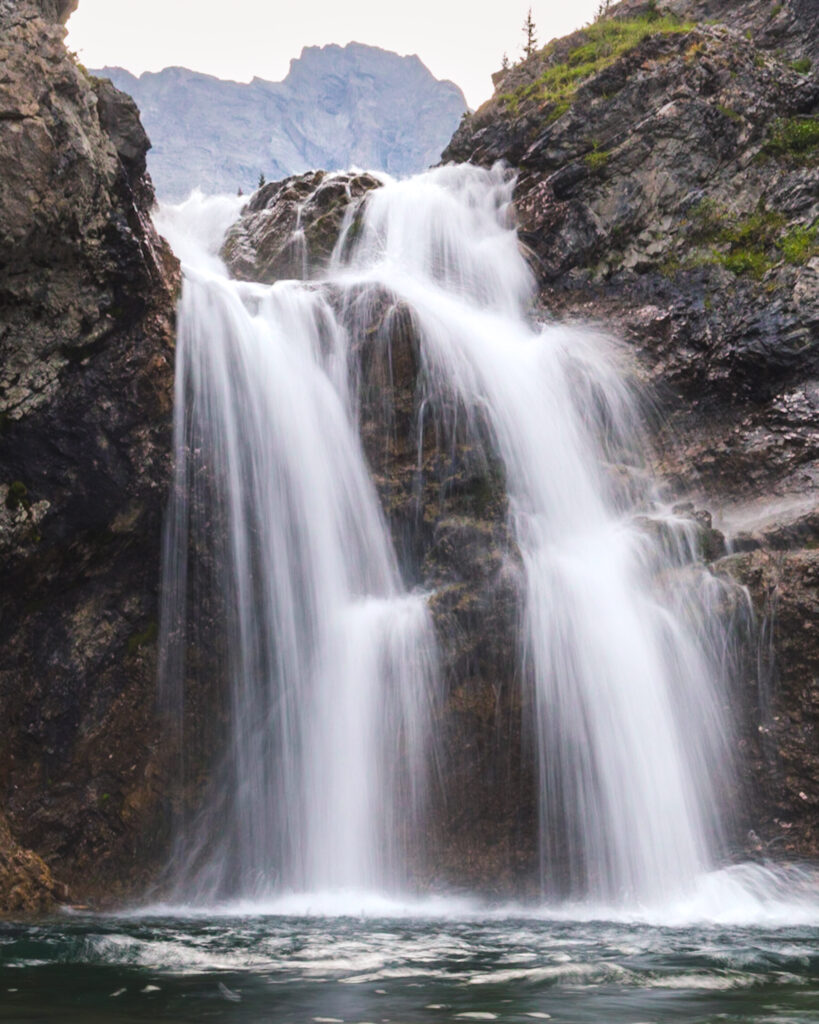
Note: The Edworthy Falls hike is located in Kananaskis Country, meaning that a valid park pass is required. Day passes can only be purchased online and are per day per vehicle, but if you’re staying six days or longer, it’s more cost-effective to just buy an annual pass instead.
Before visiting Kananaskis Country it’s essential to read up on the Alberta Parks rules that must be followed to avoid tickets and/or fines. Harmful practices that are illegal in Kananaskis Country include disturbing plants or rock-stacking, or removing any natural object from flowers to rocks, as it’s important to leave the environment as natural as possible for the animals and for fellow hikers to enjoy in perpetuity. As many flowers as there are, there are few enough that if we all took one, then there wouldn’t be any left. Take only photos, leave only footprints.
If you haven’t heard of Leave No Trace principles, they’re also really essential to read up on before heading anywhere into the outdoors in general. Following these important principles basically means doing your best to leave beautiful places like Edworthy Falls as good (if not better) than you found them, both for their preservation and for the enjoyment of other visitors.
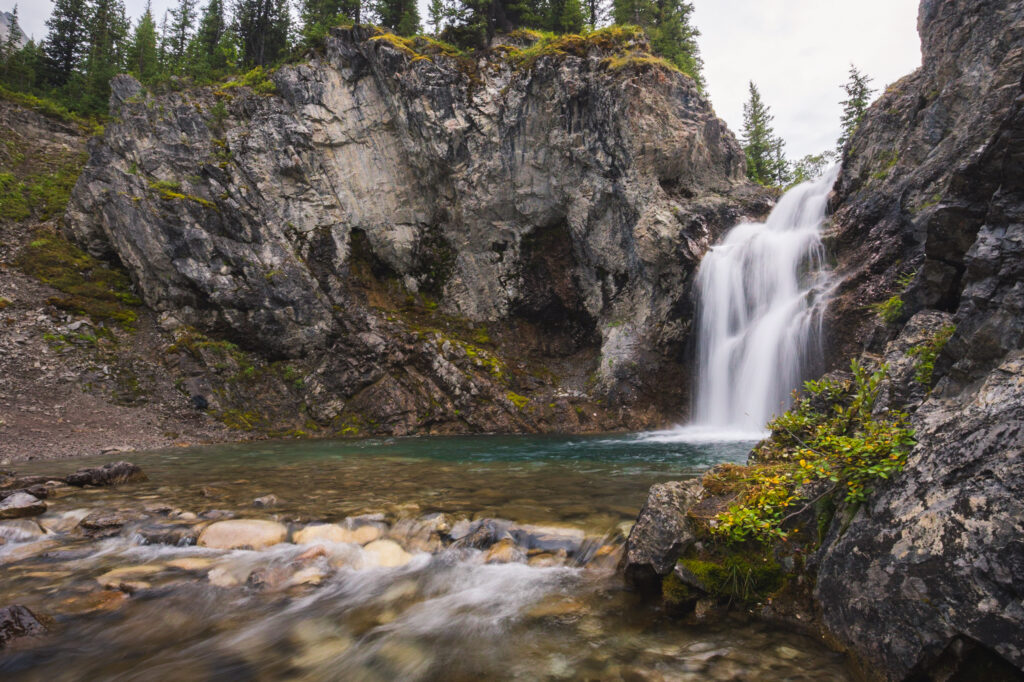
Edworthy Falls Round Trip Details
Distance: 10 KM / 6.2 MI
Elevation Gain: 400 M / 1312 FT
Hiking Time: 3-4 Hrs
Hiking & Safety Tips
- Prepare for the possibility of wildlife encounters. Bear spray is a must whenever travelling in bear country, as well as learning how to use it. Though your chance of an aggressive bear encounter is low, it is always better to be prepared with bear spray. Bear bells are proven to be an ineffective bear deterrent, and are actively discouraged by Parks Canada. The best way to let bears know you’re around is simply to use your voice. Make sure to keep a respectful distance from wildlife and never feed the animals. It may seem kind but it doesn’t just kill wildlife and put people in danger, it’s also illegal.
- Research current trail conditions and make sure you are well-informed about the route before you leave, and assess if it is within your capability. Be aware of what time it gets dark and check the weather forecast. Make sure to tell someone where you’re going and when you expect to return. Every year as more and more people try hiking for the first time, the number of rescues goes up. Being prepared is the best defense.
- Pack everything you need for a successful hike, including enough water and energy-rich snacks. Remember to pack out everything you pack in though – don’t expect to find a convenient garbage can halfway up the trail. Bring appropriate layers (remember you’ll warm up once you start hiking) and sun protection. Hiking poles may be helpful but are not required. In addition to not leaving any garbage on the trail yourself, I highly recommend bringing a garbage bag and collecting any trash that you do see on the trail. You’re guaranteed to make the hike to Edworthy Falls a more enjoyable experience for the next person.
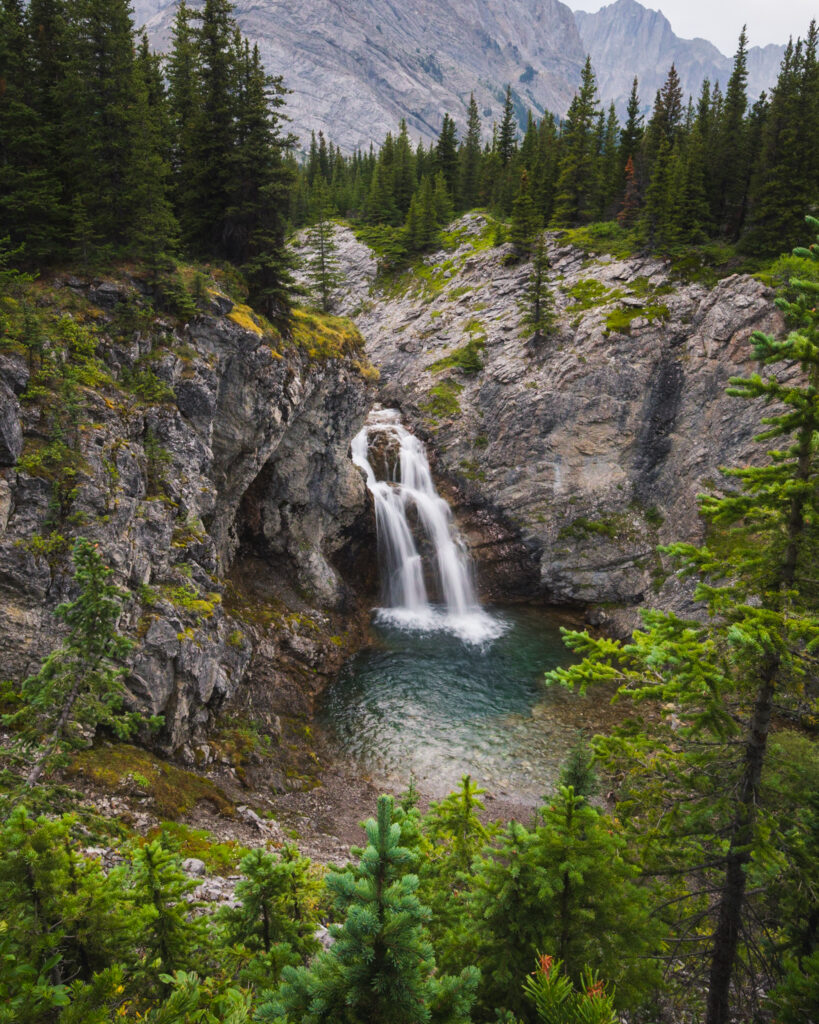
When to Visit Edworthy Falls
Like many waterfalls in the Rockies, the best time of year to visit Edworthy Falls is in late Spring. Melting snow and recent rainfall mean that the water level is at its highest, and the waterfalls at their most dramatic. Later in the year Edworthy Falls still seems to flow decently though, and is still worth visiting. When planning a hike to Edworthy Falls, I would avoid midday on summer weekends though. This trail is a popular one, and at peak times you’ll be sharing it with a lot of people. Also, the trail down to the base of the falls is steep and would be very slippery when wet, so if you’re planning on following it all the way down I’d make sure not to visit on a rainy day.
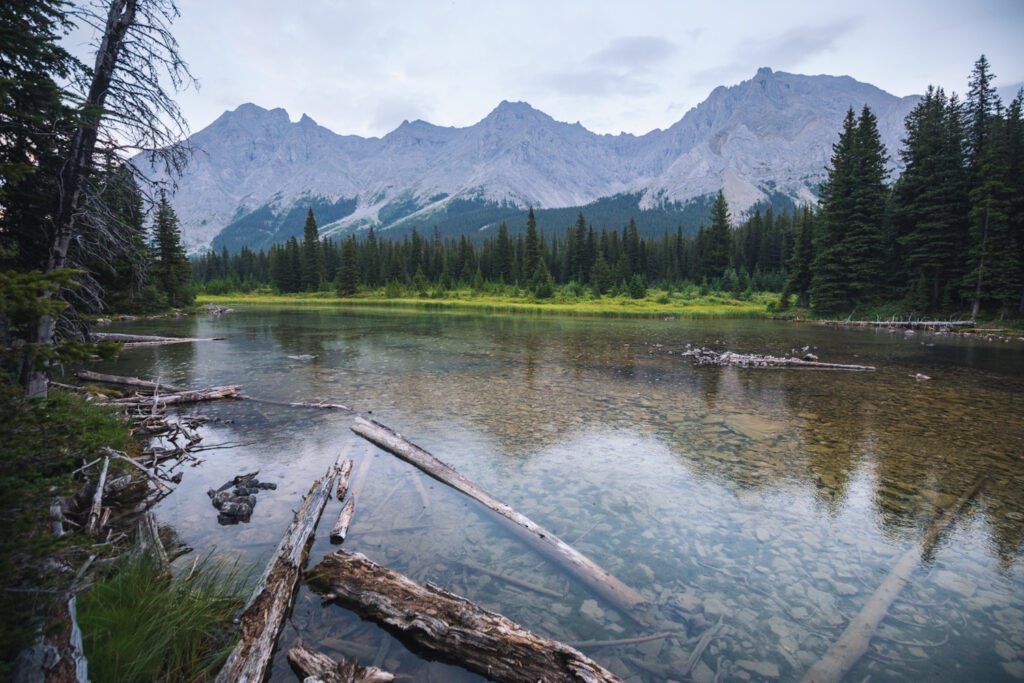
How to Get to Edworthy Falls Trailhead
The Edworthy Falls hike starts from a large parking lot in Peter Lougheed Provincial Park, not too far from Kananaskis Lakes. The parking lot is one hour from Canmore, an hour and twenty minutes from Banff, or over an hour and a half from Calgary. From Highway 1 east of Canmore, turn south onto Highway 40 at the Stoney Nakoda Casino. After about fifty minutes of driving down the scenic Highway 40 you’ll reach the large parking lot on your left. Make sure to download maps ahead of time as you’ll lose cell service before this point.
Click here to open the exact trailhead location in Google Maps.
Hiking to Edworthy Falls
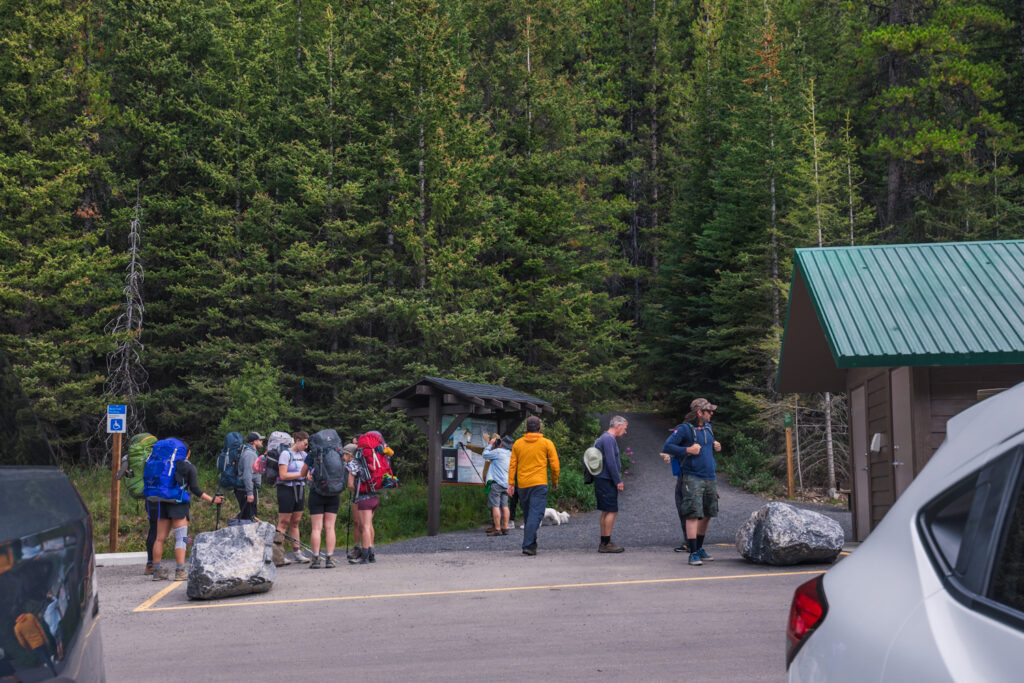
The start of the Edworthy Falls hike is shared with families just doing the short hike up to the lake as well as more serious hikers doing multi-day backpacking trips. The parking lot is large but still fills up regularly. The trail begins from the middle of the parking lot right by the pit toilets.
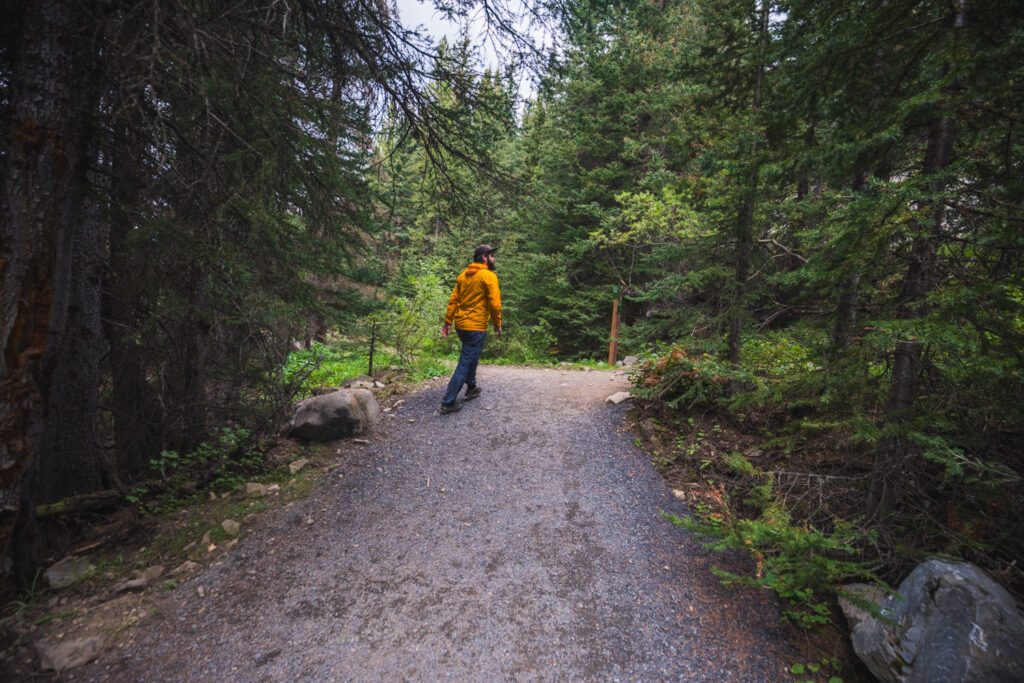
After a couple minutes turn right to begin heading uphill towards Elbow Lake.
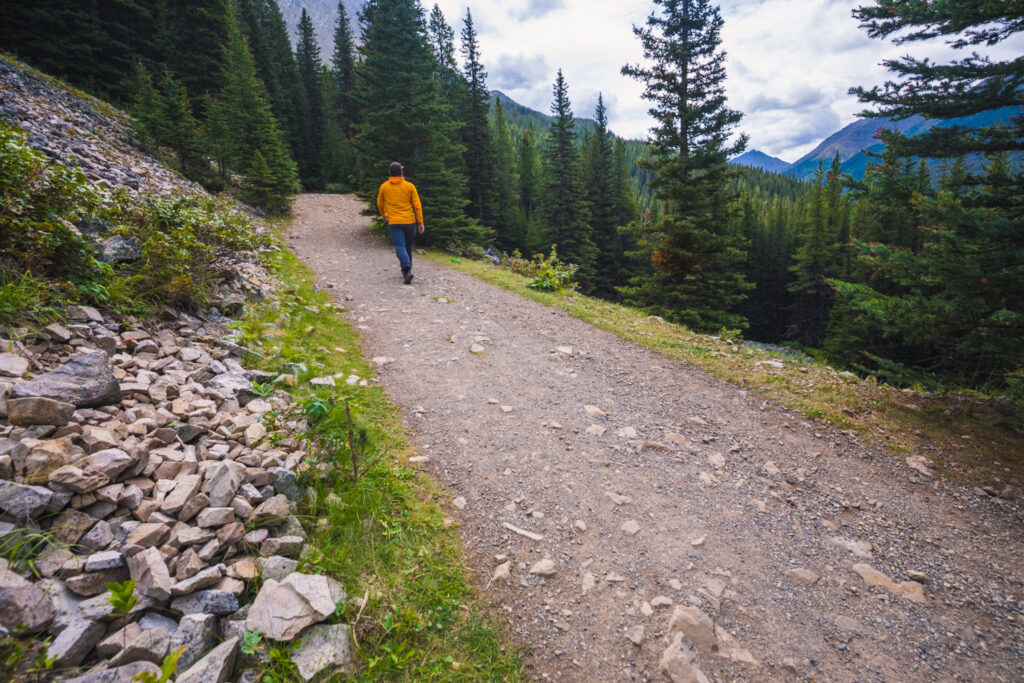
The trail crosses a couple of talus fields that offer opportunities for decent views into the valley below. Listen for the squeaking of pikas living amongst the rocks.
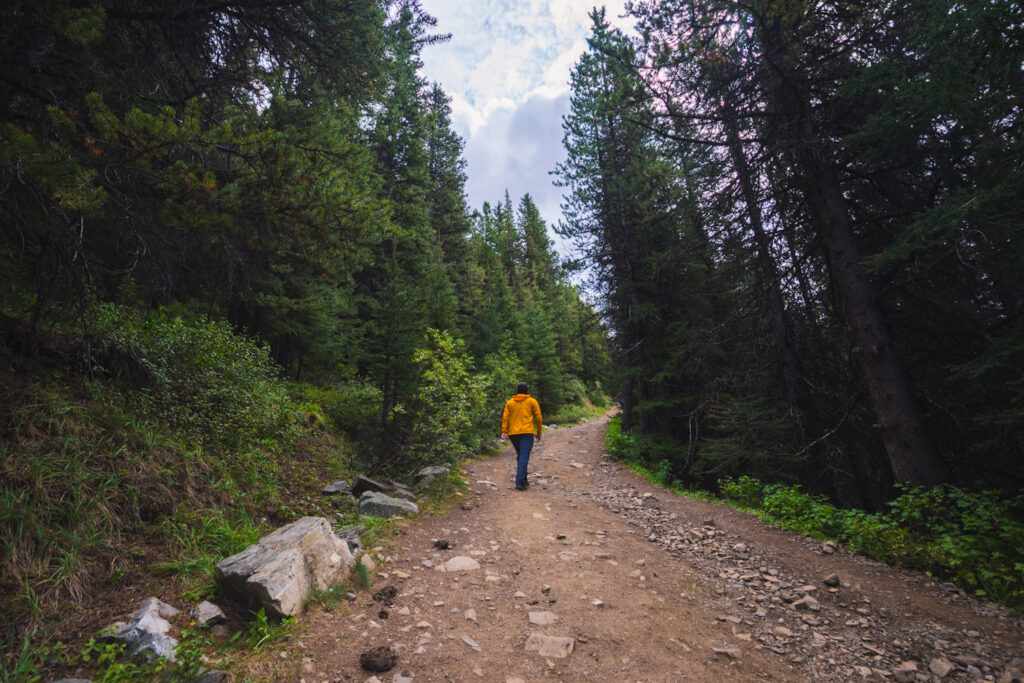
The trail up to Elbow Lake gets steep, but shouldn’t take more than half an hour at most. After that it’s a slightly downhill grade the rest of the way to Edworthy Falls.
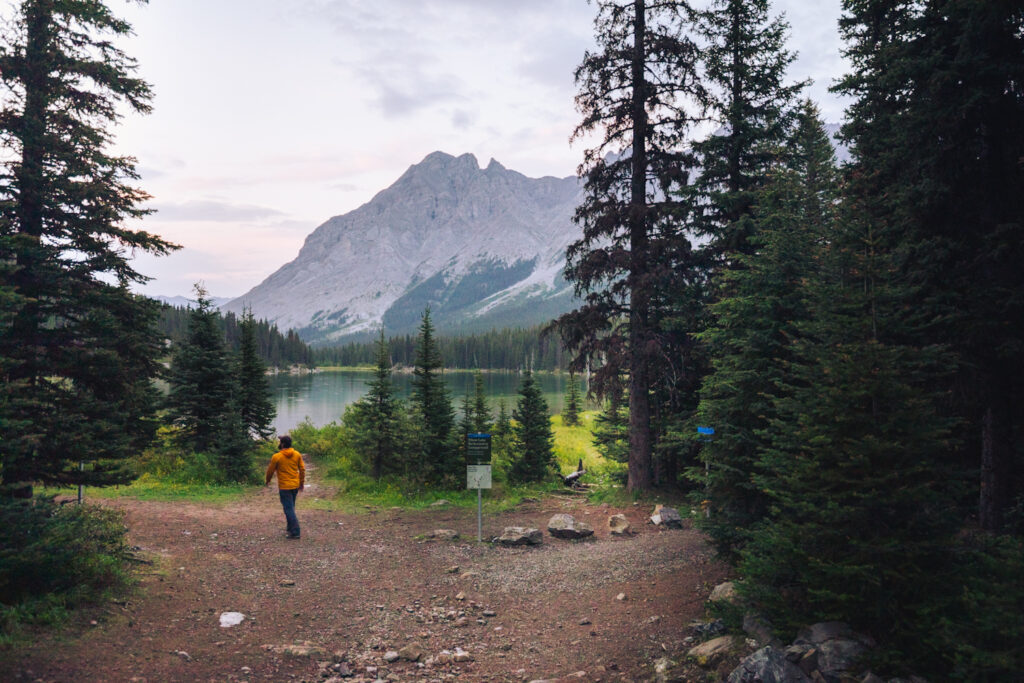
Beautiful Elbow Lake. Head left to follow the trail past the lake. On the right side of the lake is the campground. Sadly due to the east access Elbow Lake is popular among the kind of disrespectful hikers who blast their music and leave bags of poo lying around on the trail. (I ended up carrying six bags off the trail with me.) Fortunately once past the lake the trail quiets down a bit.
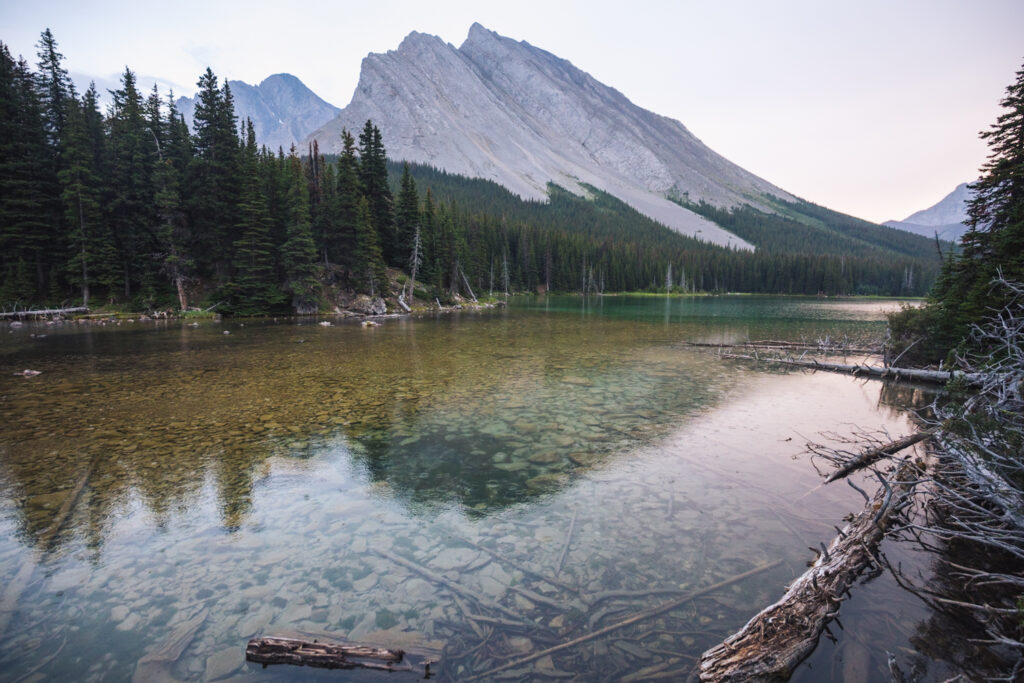
Mt Rae is visible across Elbow Lake.

These unnamed peaks are also a part of Mt Rae.

On the other side of the lake the Edworthy Falls trail continues down the valley.
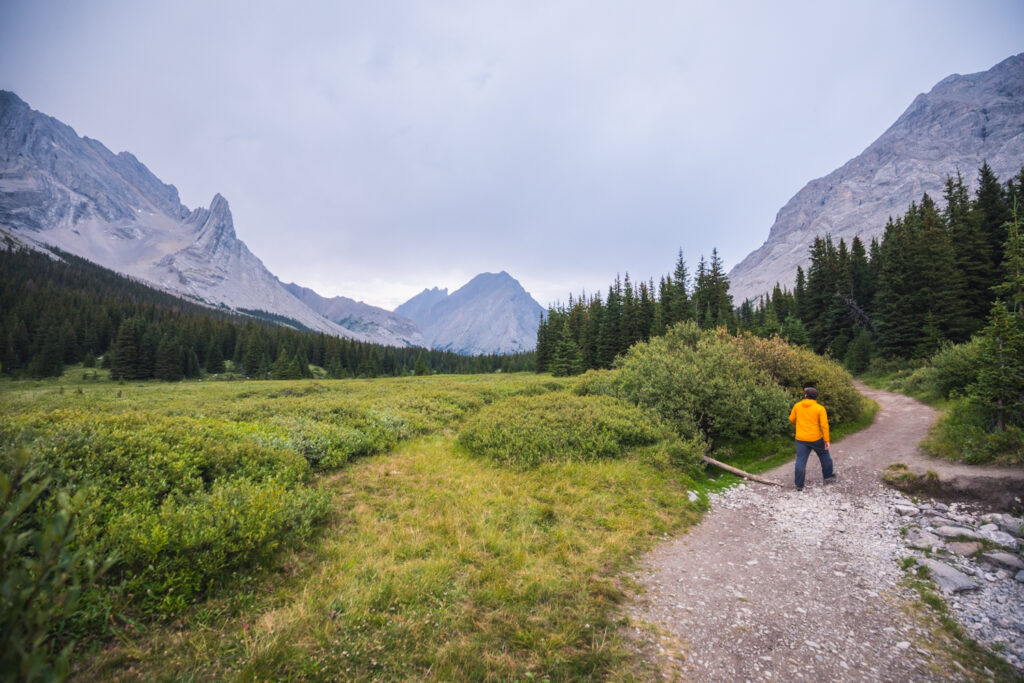
Tombstone Mountain is the distant peak at center. The trail passes Elpoca Mountain (left) as it proceeds through the valley.
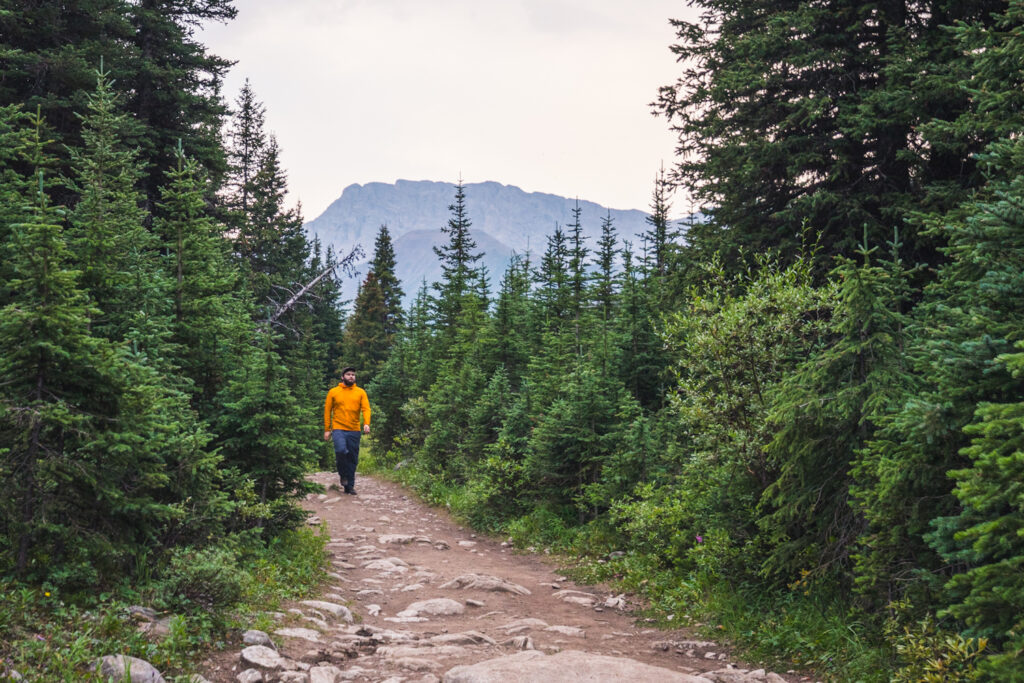
Views mostly disappear as the trail to Edworthy Falls becomes forested on either side, but the mountaintops still poke through.
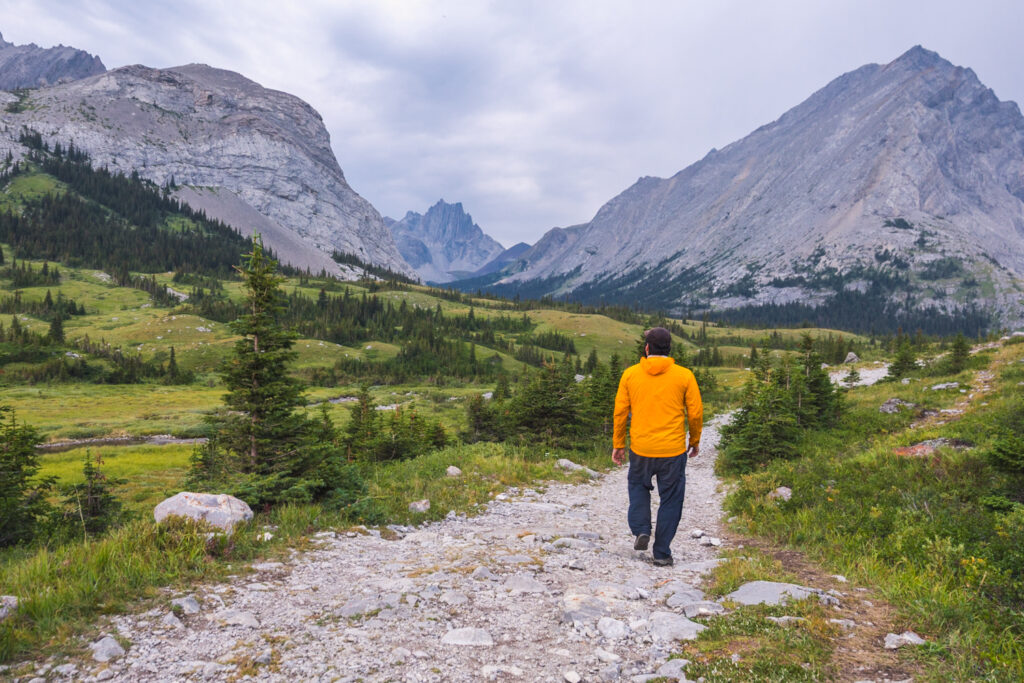
Once out of the forest, the rolling grassy hills are absolutely spectacular. The Elbow River can be seen to the left of the trail.
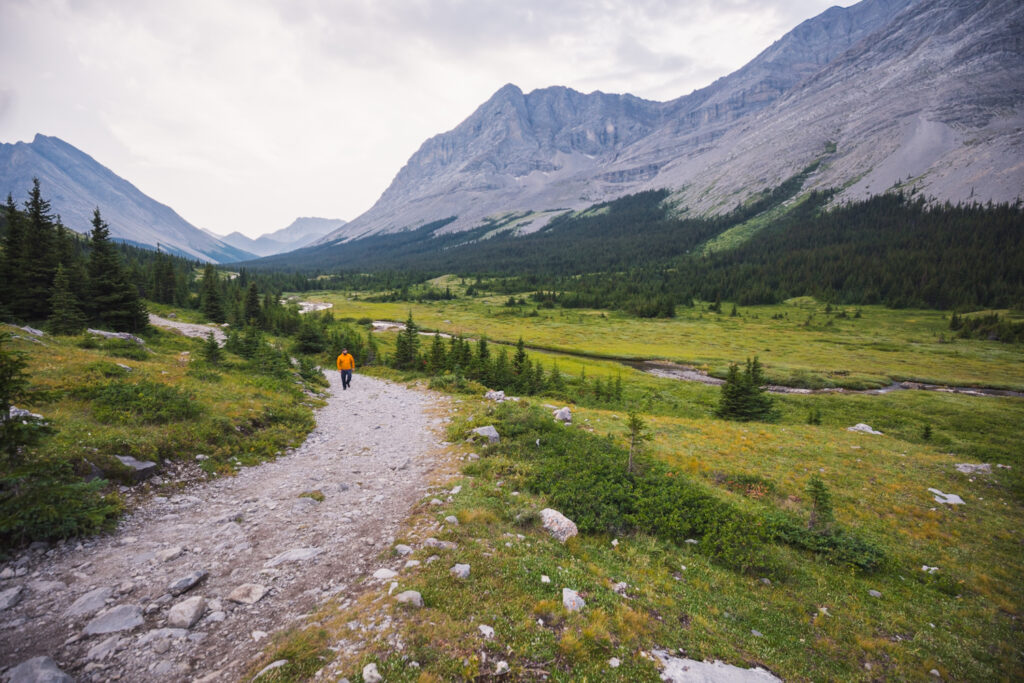
Views looking back.

A flagged trail with a large rock pile next to it marks the turnoff towards Edworthy Falls. I think they’re audible from here as well.
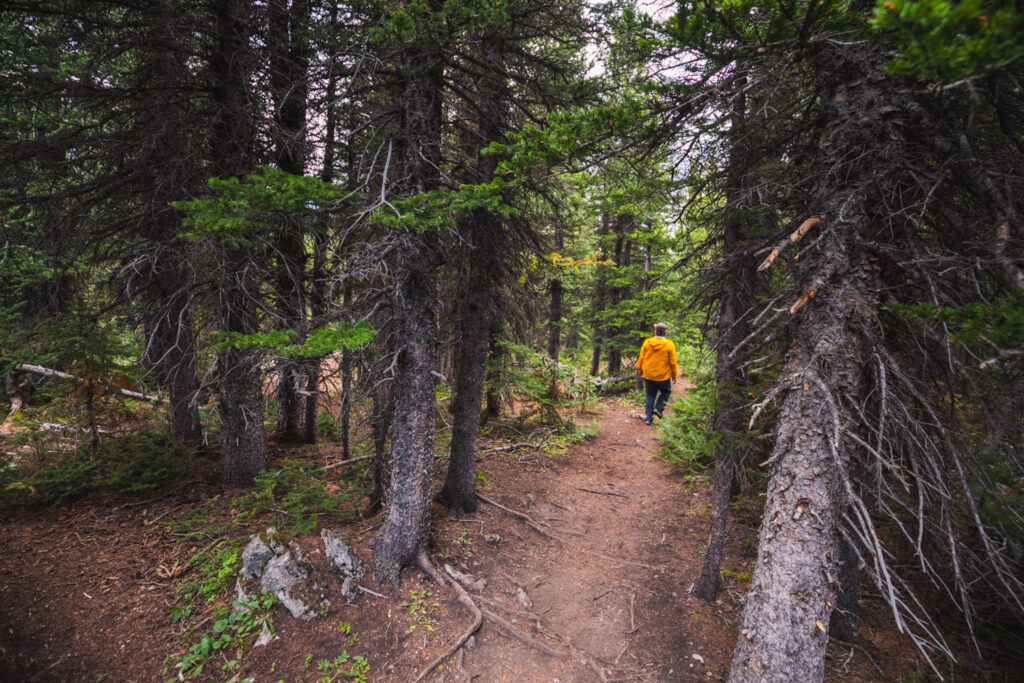
There are way too many braided trails crisscrossing through the woods here for some reason. Keep generally straight and you’ll wind up at the viewpoint for Edworthy Falls.
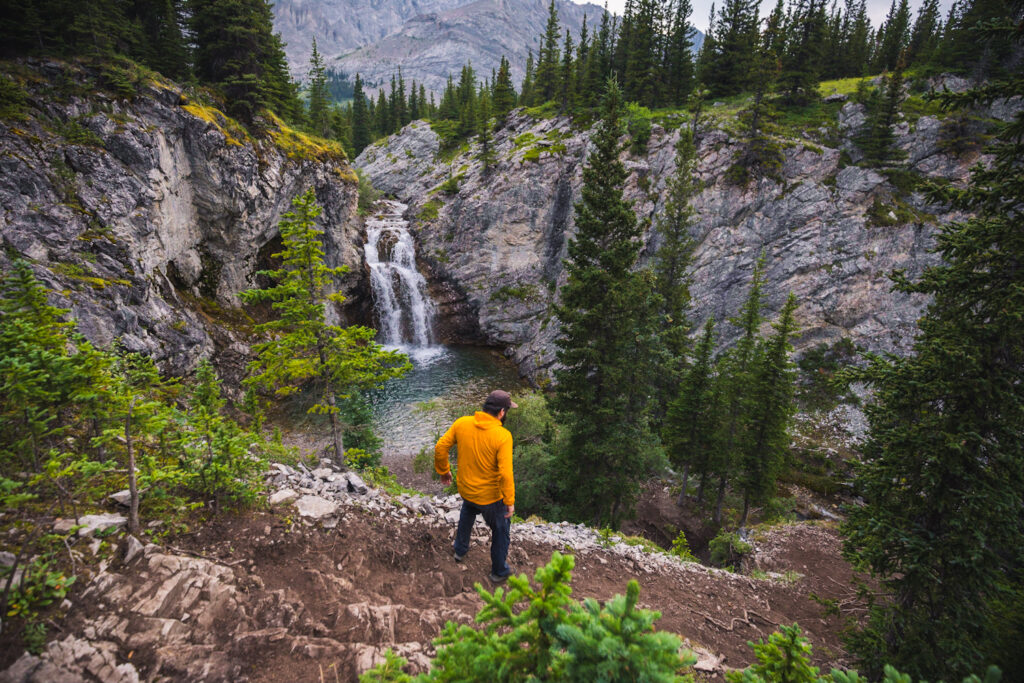
Some of the best views of the falls are from right here without even going down to the base of the falls. If you do follow the trail down to the base if the falls be careful as it’s quite steep and looks like it would be very slippery when wet.
Recommended Hiking Gear



Water is a must whenever I’m hiking, especially if the sun is going to be out. My favourite water filter I’ve used is the Katadyn BeFree 0.6L, which unlike other water filters I’ve used packs up really small and lightweight. For hikes where I know there won’t be any readily available water sources along the way, I make sure to bring my own. The Hydrapak Stow 1L bottle is my go-to, for the same reason that it’s made of a soft plastic that folds up and doesn’t take up any more extra space than necessary in my pack. Finally, Aquatabs are another great option for purifying water, with one tablet being suitable for one litre of water. I previously used the Grayl water filter while travelling internationally, and though I found its hard body more convenient for day to day use and easier to drink from, it has a little too much bulk for my fast-and-light style of hiking.



The secret to all my photos of gorgeous sunset and sunrise mountaintop views? A lot of hiking in the dark. And let me speak from personal experience when I say that the last thing that you want to happen when hiking is to be caught in the dark without a headlamp. I used the Black Diamond Spot 400 for years and it worked great – until I lost it on top of a mountain somewhere. The only downside to it was having to worry about the batteries dying, though there’s also a slightly more expensive version that has a rechargeable battery. Nowadays I’m using the Petzl Actik Core, which is a bit pricier than the more budget-friendly Black Diamond, but is also brighter, more comfortable (in my opinion), and has a hybrid power system that is rechargeable but can also take AAA batteries if needed.
You won’t see me using trekking poles on shorter hikes often – but on long hikes and backpacking trips, as well as certain scrambles, they are an absolute lifesaver. I’ve invested in a high quality ultra-lightweight pair of MSR DynaLock Ascent carbon poles which, while pricey, I don’t regret one bit. If you’re not entirely sure how much use you’re going to get out of a pair of trekking poles, the best budget-friendly option would be the Trekology Trek Z 2.0. Amazon does sell a lot of cheaper Made in China-style trekking poles for cheaper, but these usually are much much heavier and not worth buying.
All the best and most long-lasting cables and power banks I’ve ever owned have been Anker. I once had a phone cable from them that lasted me over three years of daily use! That’s why I keep an Anker PowerCore Essential 20K power bank on me. Like many people I use my phone for a lot of stuff when hiking (checking in with family, using online maps, taking photos, flying my drone) so I like to be prepared for that low battery warning by having a backup power source on me just in case.



The only socks I ever buy for myself are from Darn Tough, and I almost always make sure to wear them when hiking. After years of having no problems only wearing these comfortable and rugged socks for hikes, I accidentally wore a pair of no-name socks on a hike last year and ended up with blisters on both feet. Safe to say I’m back to sticking with the Darn Tough. And the best part? They have a lifetime guarantee, meaning that if they ever wear out you can send them back for a brand new pair. For hiking footwear I go between a pair of lightweight approach shoes for quick and dirty mountain ascents or anything involving scrambling and more heavy-duty boots for longer treks. I’ve worn a couple different versions of the lightweight but super durable Arc’teryx Konseal FL 2 approach shoes for a few years now and am very impressed with the durability. I also really like the thick toecap that keeps me protected every time I stumble into a root or large rock. For longer, tougher, or muddier treks I rely on my LOWA Camino EVO GTX, which I find insanely comfortable and made of very high quality.



I wear my Ar’teryx Gamma Lightweight Pants on every single hike I go on, and on many days when I’m not hiking. After several years of abuse they are still holding together extraordinarily well, with only a few small holes from where I’ve fallen down and some slight stains from being repeatedly coated with mud. They’re lightweight, breathable, and super comfortable. For lightweight and breathable hiking tops I’m a big fan of both the Patagonia Capilene Shirt and the MEC Core Shirt. My Arc’teryx Squamish Hoody shows up in a lot of my photos. It’s super lightweight and packable, and does a great job of cutting the wind while also being pretty breathable. I also have an Arc’teryx Atom Hoody and Arc’teryx Beta LT that I pull out for cooler or wetter conditions.
I hope you enjoyed this guide to hiking to Edworthy Falls in Kananaskis Country! Feel free to leave any questions in the comment section below or to contact me directly via social media.
